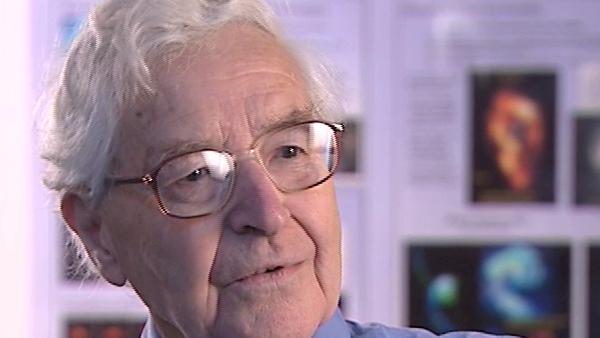In the early days of our work at the Lord's Bridge Observatory I was… I was still chasing the solar atmosphere, but then we discovered in 1964, eventually, that you could discover twinkling from the… from the… from what was then the solar wind; the Sun's atmosphere actually blows off… off the Sun and we discovered that you could detect on radio galaxies and quite a lot of sources a rapid twinkling effect, which was radio scattering in the… in the solar wind, which is the far out solar atmosphere.
By then we were entering the space age in the 1960s, people had just begun to measure the solar wind in the spacecraft. And with others I… I had discovered that this twinkling, which I knew all about from my ionospheric work, my PhD work, that you could detect the same twinkling if you looked at certain radio galaxies. These were the quasars; the quasars contained tiny bright components, often in the nucleus, and it's those bright components which actually cause the twinkling. Larger sources don't… don't twinkle because the twinkling is… is smeared out and it's the same old story that planets don't twinkle and stars do.
If you look in the sky the planets are too large and angular size and, in the early days of radio astronomy, when we didn't have any kind of imaging techniques, it was a very different area then. We just… we knew that the sources were up there but didn't know how large an angle they subtended. I decided I could use this scintillation effect to measure angular sizes and that led me on to the antenna, which finally led to the discovery of… pulsars. Because I… I thought that this scintillation would be an excellent way of sorting out in the sky which were the quasar sources and which were the standard radio galaxies. We had no other means of doing it in those days. I mean, long baseline and interferometry was only just beginning, there were absolutely no imaging instruments around. And… so while Ryle was, in the early days at Lord's Bridge, was mapping the sky and counting radio galaxies and doing his early cosmological work with students, I… I decided that I'd set up a big antenna to look at this scintillation over the whole sky and then use that to detect which of the radio galaxies… in the 1960s we knew about 1000 radio galaxies; with my antenna I decided that we would be able to look at those and see which of them were the quasars and which were not, and that I thought was a very interesting and useful thing to do. But it needed a special antenna to do that and, because of my background with doing practical things with Martin Ryle, I saw really what I had to do. I… I just built a huge simple antenna on the ground.
It had to operate at a longish wavelength because that's where the solar plasma, the solar wind, shows up best in this scintillation. It had to work at meter wavelengths and that meant dipole antennas and I covered four acres of the – actually four-and-a-half acres - at our site at Lord's Bridge with dipole antennas, about 2000 of them, 2048 to be precise. And this was a very sensitive antenna but it was quite a clever antenna because I wanted to scan the sky and I arranged it as a phased array, so that the antenna reception beam could be pointed at different parts of the sky, and we could look at 16 parts of the sky simultaneously. And it was when I'd got that antenna designed and just beginning to build it that my student, Jocelyn, arrived to help as one of my graduate students in analysing the data – and we're going back now to, what are we? I'm talking about 1965, it was 1965 I designed this huge antenna and built it at Lord's Bridge with help and we started the survey in 1967. And quite by chance it was just an ideal instrument for detecting pulsars, which was the great discovery which really made my name in the… in the field, and that's… that's how that happened.
Now, that kind of luck doesn't happen to many people but if you're in a new field doing something different… I've never actually wanted to follow the… doing exactly what other people are doing. I… I like to have my own project if I can and get something with my students that's not just doing standard research, as it were, but doing something quite new. And that's… that's what happened with the scintillation and it wasn't long before we began to hit upon these rather strange signals we now call pulsars.





